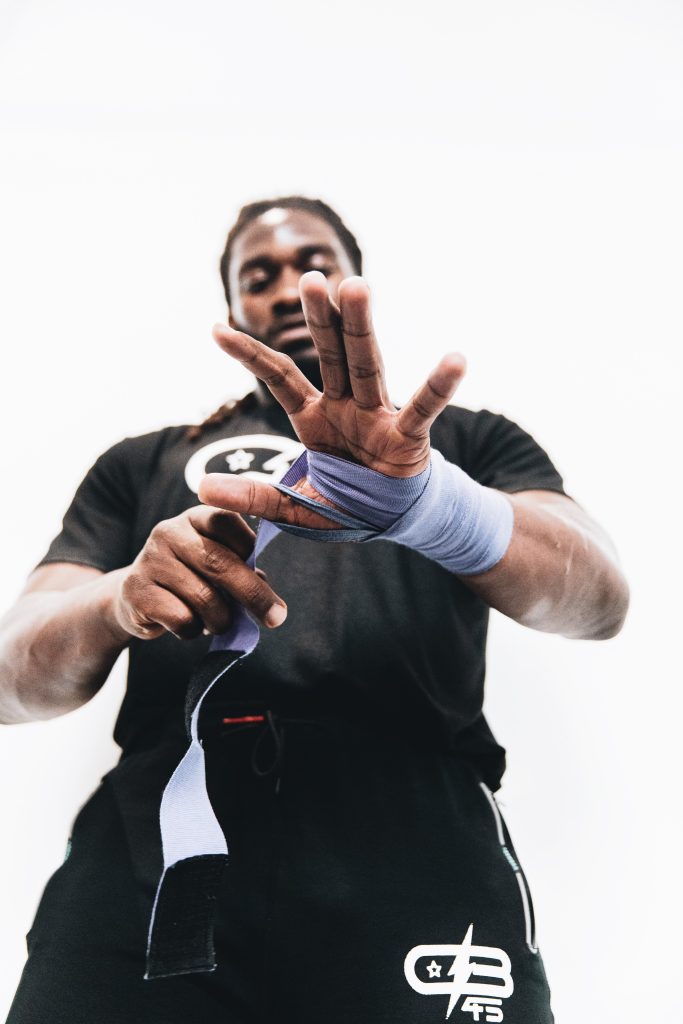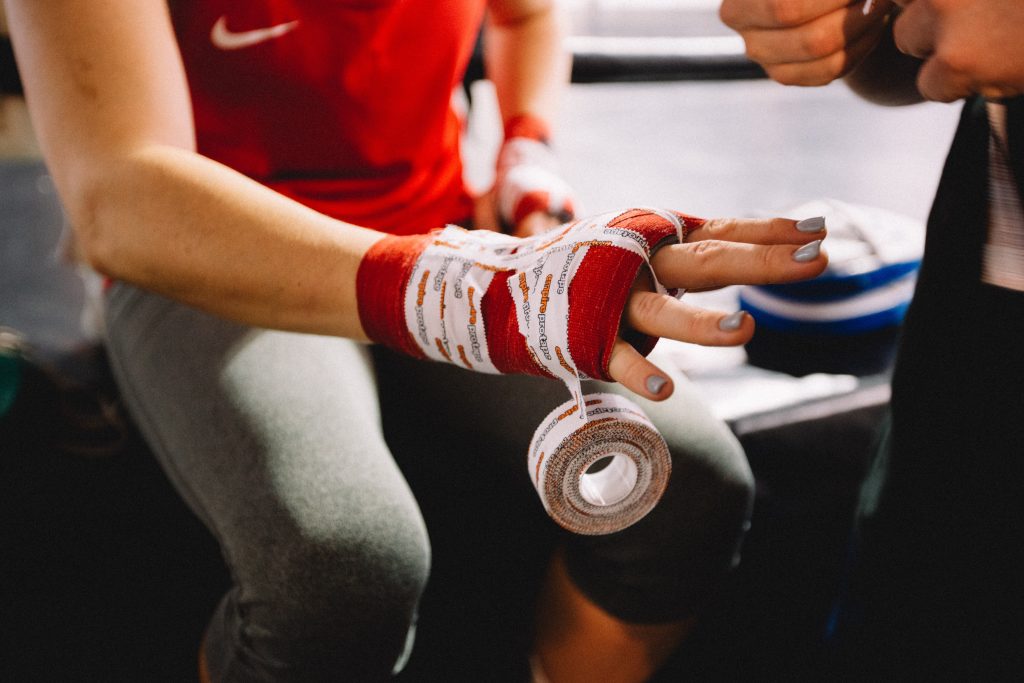
It’s imperative for boxers to know how to wrap hands for boxing correctly. This method of hand wrapping acts as a vital protective measure, guarding the wrists, knuckles, and bones in the hand against potential harm during workouts and matches.
By effectively wrapping your hands, you can enhance stability, support, and overall performance, allowing you to unleash your punching power with confidence.
In this guide, we will walk you through the step-by-step process of hand wrapping for boxing, providing you with valuable techniques and insights to ensure a secure and comfortable fit. Whether you’re a beginner or an experienced fighter, mastering the art of hand wrapping will significantly contribute to your safety and success inside the ring.
We have also prepared a review of Best Hand Wraps for Boxing for you, you can watch it here
Table of Contents
- 1 How to Wrap Hands for Boxing
- 2 Why Wrap Hands for Boxing?
- 3 Types of Wraps to Use for Boxing
- 4 Considerations for Wrapping the Hands for Boxing
- 5 Traditional Boxing Wraps
- 6 How Tight Should You Wrap Your Hands for Boxing?
- 7 Can I Hit a Heavy Bag with Just Hand Wraps?
- 8 Hand Wraps vs. Boxing Gloves: Which Is Better?
- 9 Conclusion
- 10 FAQ
How to Wrap Hands for Boxing
How to wrap hands for boxing is an essential skill for every fighter. It not only provides crucial protection against injuries but also enhances wrist stability and overall punching performance. So, let`s talk about a step-by-step process on how to wrap hands for boxing, ensuring maximum support and comfort during your training sessions and fights.
Step 1: Unroll Your Hand Wrap
Start by unrolling the hand wrap completely, ensuring that it is free of tangles or twists. Hold one end of the wrap firmly in your hand while allowing the rest of the fabric to unravel smoothly. This step sets the foundation for a well-wrapped hand, ready to provide the necessary protection and support throughout your boxing session.
Step 2: Place your Thumb Through the Loop
Locate the loop at the end of the hand wrap, designed to secure your thumb. Slide your thumb through this loop, making sure it sits comfortably and securely. The loop will serve as an anchor point, ensuring that the wrap remains in place and providing added stability for your thumb during punches.
Step 3: Wrap the Wrist
Begin wrapping the hand wrap around your wrist, starting from the bottom side of your hand near the pinky finger. Wrap the fabric firmly but not too tight around your wrist, moving in a circular motion. Ensure that the wrap covers the wrist joint completely, providing essential support and stability for your punches. Continue to wrap the fabric around your wrist for a few rounds, gradually working your way up toward the base of your thumb.
Step 4: Wrap the Hand
From the base of your thumb, continue wrapping the hand wrap diagonally across the back of your hand, moving towards the opposite side near the base of your pinky finger. Make sure to overlap the previous layer by about half of its width with each wrap, gradually covering the entire back of your hand. This diagonal wrapping technique helps secure the hand and provides additional protection to the knuckles and metacarpal bones.
Step 5: Wrap the Thumb and Anchor it to the Wrist
Take the hand wrap diagonally across the back of your hand, crossing over the base of your thumb. Wrap it around your thumb once, ensuring a snug but not overly tight fit. After wrapping the thumb, continue to wrap the fabric across the back of your hand and bring it down towards your wrist. Wrap it around the wrist a few times, anchoring the thumb and securing it in place. This step provides added stability to the thumb and ensures that the wrap stays securely in position during your boxing session.
Step 6: Wrap the Fingers
Starting from the base of your thumb, proceed to wrap the hand wrap around your fingers individually. Begin with your pinky finger and work your way towards your index finger, wrapping each finger securely but not too tightly. Make sure to leave the knuckles exposed for flexibility and proper hand movement. Wrapping the fingers helps provide support, prevent injuries, and maintain alignment during punches.
Step 7: Wrap the Hand Again
After wrapping each finger, continue wrapping the hand wrap across the back of your hand and back towards your wrist. This time, cover the back of the hand and the knuckles with a few additional layers of wrap. Ensure that the wrap is snug but not excessively tight, maintaining a balance between support and flexibility. This step reinforces the previous wraps, adds extra cushioning, and further secures the hand for optimal protection.
Step 8: Secure the Wrap
Once you have wrapped the hand to your satisfaction, it’s time to secure the wrap in place. Take the end of the hand wrap and carefully tuck it under the layers near your wrist. Make sure it is secure but not too tight, allowing for proper blood circulation. You can also use tape or the hook-and-loop closure provided on some hand wraps to keep the wrap firmly in place. By securing the wrap, you ensure that it stays in position throughout your training or boxing session, providing the necessary support and protection.
Why Wrap Hands for Boxing?
So, we discovered how to wrap hands for boxing. But why do it?
Hand wrapping is an indispensable practice in the world of boxing, offering a myriad of benefits that cannot be overlooked. First and foremost, hand wrapping plays a vital role in safeguarding against injuries. By providing an additional layer of padding and support, wraps help to cushion the impact of punches, reducing the risk of fractures, sprains, and other hand-related injuries.
Furthermore, hand wraps enhance wrist stability, keeping the joint aligned and minimizing the chances of strain or hyperextension during intense training sessions or fights. This stability translates into an improved punching technique, allowing for proper alignment and transfer of power from the body to the fist.

Lastly, hand wrapping has a direct impact on punching power. With a secure wrap that supports the bones and tissues of the hand, fighters can generate more force behind their punches, increasing the potential for knockouts and overall effectiveness in the ring.
Wrapping your hands for boxing is not merely a precautionary measure; it is a fundamental aspect of the sport that promotes safety, stability, and amplified punching power. Neglecting hand wrapping can lead to avoidable injuries and hamper performance, making it an essential practice for every boxer.
Types of Wraps to Use for Boxing
Here are some common types of hand wraps to consider:
- Cotton Wraps: Cotton wraps are the most traditional and widely used type. They provide excellent breathability, flexibility, and comfort. Cotton wraps are easy to find, affordable, and suitable for most boxers.
- Elastic Bandage Wraps: Elastic bandage wraps offer a snug and secure fit. They provide additional compression, which can help with joint support and reduce swelling. Elastic wraps are durable and provide a customized fit for individual hand sizes.
- Gel Wraps: Gel wraps combine the benefits of hand wraps and gel padding into a single product. They offer convenience and ease of use, as they are pre-padded and require no additional wrapping. Gel wraps provide good shock absorption and can be suitable for boxers looking for extra cushioning.
- Competition Wraps: Competition wraps are specifically designed for professional boxers and those participating in official matches. These wraps are longer and sturdier, providing maximum hand and wrist support. They often come with thumb loops for added stability during intense bouts.
When selecting a hand wrap, consider factors such as your personal preference, hand size, level of experience, and the specific requirements of your training or competition. It’s essential to choose a wrap that offers the right balance of comfort, support, and protection for your boxing needs.
Considerations for Wrapping the Hands for Boxing
When wrapping your hands for boxing, there are several important considerations to keep in mind to ensure a proper and effective wrap:
- Hand Size: Different individuals have varying hand sizes, so it’s crucial to adjust the length and tightness of the wrap accordingly. Those with larger hands may require longer wraps, while those with smaller hands may need to wrap more tightly to achieve a secure fit.
- Adjusting Tightness: The wrap should be snug enough to provide support and stability but not overly tight to restrict blood flow or cause discomfort. Strike a balance between a secure fit and maintaining proper circulation throughout your hand and fingers.
- Wrapping Techniques: Explore different wrapping techniques to find the one that works best for you. Experiment with variations, such as the number of wraps around the wrist or knuckles, to customize the level of support and comfort.
- Avoiding Common Mistakes: Be aware of common mistakes, such as wrapping too loosely, leaving gaps, or overlapping the wrap excessively, as these can compromise the effectiveness of the hand wrap. Take the time to learn proper wrapping techniques and practice them consistently.
- Regular Maintenance: Properly maintain your hand wraps by washing them regularly to keep them clean and fresh. This helps prevent the buildup of bacteria and unpleasant odors, ensuring a hygienic wrap for your hands.
By considering these factors and adopting good wrapping practices, you can optimize the protection and support provided by your hand wraps, promoting safety and maximizing your performance inside the boxing ring.
Traditional Boxing Wraps
Traditional methods and materials used for hand wrapping in boxing hold historical significance in the sport. In the early days of boxing, fighters relied on simple strips of cloth, typically made of cotton, to wrap their hands. These traditional hand wraps were primarily chosen for their affordability, accessibility, and effectiveness in providing basic protection.
The process of wrapping hands with traditional boxing wraps involved meticulously layering the cloth around the hand, wrist, and knuckles, offering essential support and padding. This technique aimed to minimize the risk of injuries and fractures during intense bouts.
While modern hand wraps have introduced innovative materials and designs, traditional wraps remain an important part of boxing culture. They symbolize the roots and traditions of the sport, connecting fighters to the history and techniques passed down through generations.
Many boxers today still appreciate the simplicity and familiarity of traditional hand wraps. They serve as a reminder of the dedication and resilience displayed by the boxing pioneers who paved the way for the sport’s evolution. Whether using traditional or modern wraps, the goal remains the same: to protect the hands and enhance performance, paying homage to the timeless legacy of boxing.
How Tight Should You Wrap Your Hands for Boxing?
When it comes to wrapping your hands for boxing, finding the right balance of tightness is crucial. Here are some guidelines to help you achieve the appropriate level of tightness:
- Support and Stability: The wrap should be tight enough to provide support and stability to your hand and wrist. It should help minimize excessive movement of the bones and joints during punches, reducing the risk of sprains or fractures.
- Flexibility and Range of Motion: While support is important, it’s equally vital to maintain flexibility and range of motion in your hand and fingers. Avoid wrapping too tightly, as it can restrict movement and hinder your ability to perform techniques effectively.
- Proper Blood Circulation: Ensure that the wrap is not too tight, as this can impede blood circulation to your hand and fingers. It’s essential to maintain proper blood flow to prevent numbness, tingling, or discomfort during training or fights.
To find the appropriate tightness, start by wrapping your hand with a moderate level of tension. As you progress, pay attention to any signs of discomfort, numbness, or restricted movement. Adjust the tightness accordingly, ensuring that you strike the right balance between support and flexibility.
Remember to regularly check your fingers for proper circulation during the wrapping process. If you notice any discoloration or loss of sensation, it indicates that the wrap is too tight and should be adjusted immediately.
By finding the optimal tightness for your hand wraps, you’ll be able to protect your hands while maintaining the necessary range of motion and blood circulation for effective boxing performance. Experiment with different levels of tension to determine what works best for you, and always prioritize safety and comfort during your training sessions and fights.
Can I Hit a Heavy Bag with Just Hand Wraps?
While hand wraps provide some level of protection, it is not recommended to hit a heavy bag with just hand wraps. Here are a few reasons why using boxing gloves is crucial for heavy bag training:
- Hand and Wrist Safety: Hand wraps alone do not offer sufficient padding and impact absorption to protect your hands and wrists during intense heavy bag workouts. The repeated force of your punches can strain the bones, joints, and soft tissues of your hands, leading to injuries such as sprains, fractures, or even long-term damage.
- Impact Distribution: Boxing gloves are specifically designed with padding to distribute the impact of your punches across a larger surface area. This helps to reduce the stress on your knuckles and minimize the risk of bruising or injuring your hands.
- Longer Training Sessions: Using only hand wraps can limit the duration of your heavy bag training sessions. The lack of proper cushioning increases the chances of fatigue and discomfort, making it harder to sustain a longer and more productive workout.
- Technique Development: Boxing gloves provide better feedback and responsiveness, allowing you to focus on refining your punching technique. With gloves, you can work on proper fist formation, accuracy, and power without worrying about injuring your hands.
To ensure the safety and longevity of your hands, it is strongly recommended to use boxing gloves in conjunction with hand wraps when hitting a heavy bag. The combination of both provides optimal protection, support, and comfort, allowing you to train effectively and reduce the risk of hand injuries.
Invest in high-quality boxing gloves that fit well and provide adequate padding. Remember to always wrap your hands properly before putting on your gloves to maximize their effectiveness.
By using the appropriate gear and following proper safety protocols, you can enjoy a productive and injury-free heavy bag training session while improving your boxing skills.
Hand Wraps vs. Boxing Gloves: Which Is Better?
When it comes to hand protection in boxing, both hand wraps and boxing gloves play important roles, and it’s not a matter of one being better than the other. Let’s compare their benefits and purposes:
Hand wraps are essential for providing added support, stability, and protection to the hands and wrists. They help secure the bones and joints, reducing the risk of injuries during training or fights. Hand wraps also assist in maintaining proper alignment, enhancing punching technique and power. They serve as a foundation for the next layer of protection—boxing gloves.
Boxing gloves are designed with padded cushioning to absorb the impact of punches and protect both the wearer and the opponent. They offer additional hand and wrist support, distributing the force across a larger surface area. Boxing gloves also help in regulating the intensity of sparring sessions or bag workouts, reducing the likelihood of injuries.

The combination of hand wraps and boxing gloves provides optimal hand protection and performance benefits. Hand wraps reinforce the structure of the hand, offering support and preventing potential injuries. Boxing gloves, on the other hand, act as a protective barrier, dispersing the impact and safeguarding your hands and your opponent from excessive force.
It is crucial to understand that hand wraps and boxing gloves complement each other. Hand wraps provide internal support, while boxing gloves provide external cushioning and safeguarding. Using both together ensures comprehensive hand protection, allowing you to train and compete with confidence.
Remember, invest in high-quality hand wraps and boxing gloves that fit properly and prioritize safety. Always wrap your hands correctly before putting on your gloves to maximize their effectiveness.
Conclusion
By making hand wrapping an integral part of your boxing routine, you demonstrate a commitment to your safety and long-term success. Whether you’re a beginner or an experienced boxer, taking the time to wrap your hands properly is a simple yet powerful step towards safeguarding your hands and improving your performance.
Remember, hand wrapping is not just a formality; it’s an essential practice that should be followed diligently. Prioritize the health and well-being of your hands by investing in high-quality hand wraps, learning proper wrapping techniques, and making it a habit before every training session and fight.
Wrap your hands with care, and enjoy the confidence and peace of mind that comes with knowing you’ve taken an important step towards boxing success.
FAQ

I’m Heorhii Rysak, a go-to sports enthusiast and blogger. My fascination with sports began in my childhood with karate, setting the foundation for my love of physical fitness. Over the years, I’ve delved into various disciplines, including martial arts and CrossFit, and developed a passion for tennis. I bring a wealth of practical experience to my blog, where I share equipment reviews, workout plans, and fitness advice. My goal is simple: to inspire and assist you in your journey toward better health and performance.